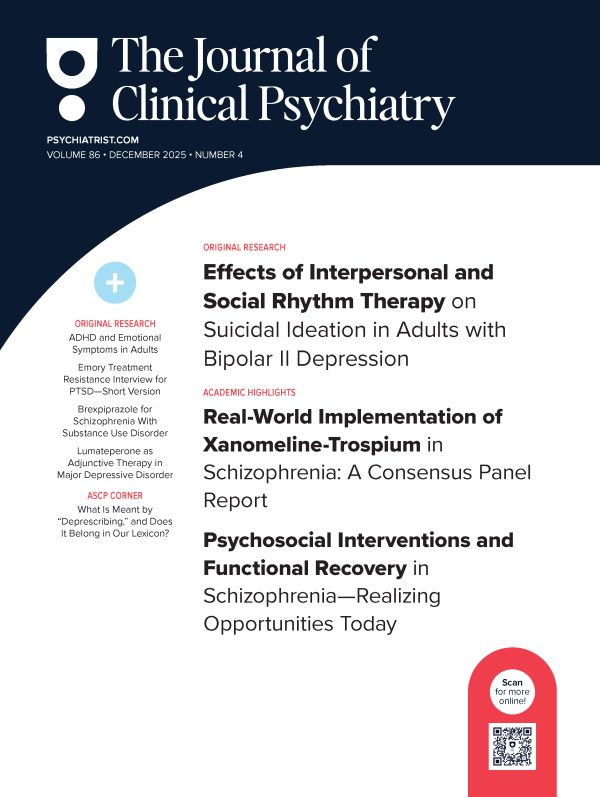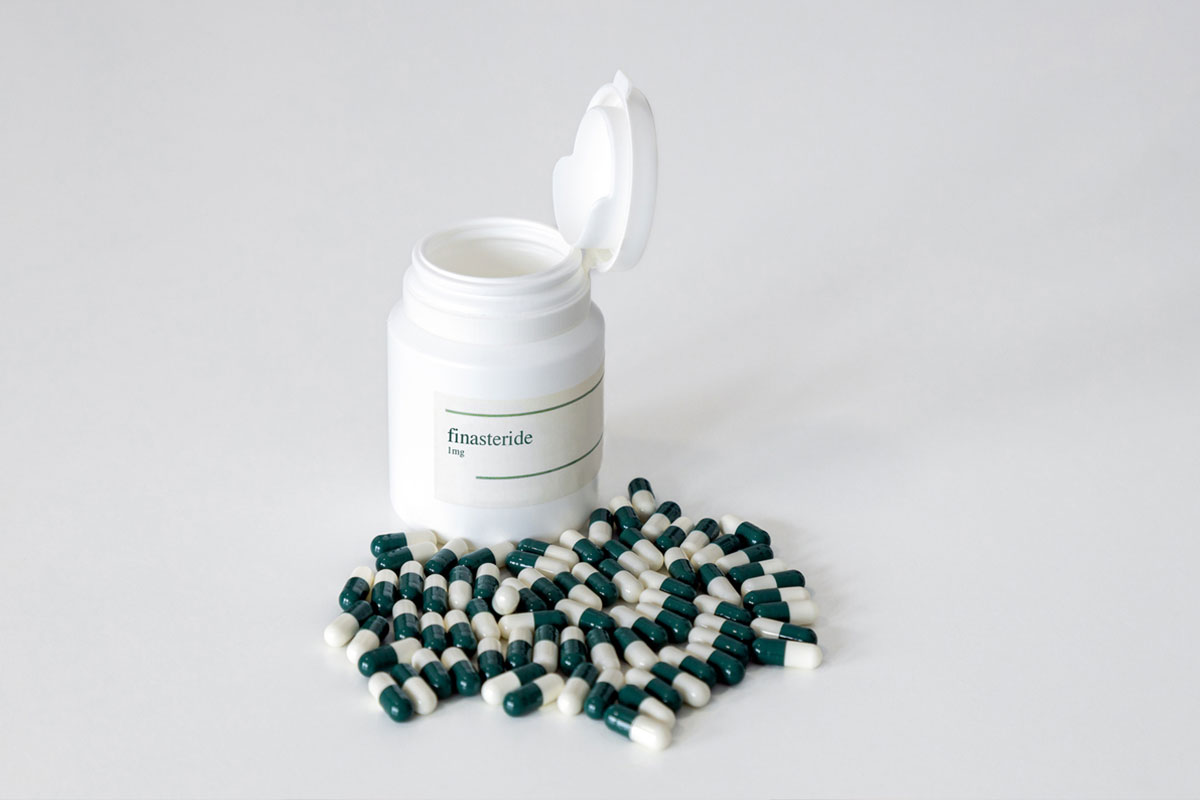Twenty-five years have passed since Krystal and colleagues’1 groundbreaking report that the NMDA antagonist ketamine hydrochloride, infused over 40 minutes at a subanesthetic dose, has rapid-acting antidepressant properties. Since then, many thousands of patients have received ketamine, and new formulations and routes of administration have proliferated. To mark the anniversary, 2025 brought near-simultaneous, seemingly contradictory, reports: while the FDA expanded esketamine’s labeled indications to include use as monotherapy for treatment-resistant depression, a new meta-analysis cast doubt on the durability of the patented enantiomer’s antidepressant properties and called into question its value in treating acute suicidality entirely.2,3
Few psychotropic medications have generated as much excitement as racemic ketamine and esketamine while simultaneously prompting as much uncertainty. While esketamine’s efficacy in comparison to racemic ketamine warrants further evaluation, patient safety must also be prioritized as community practitioners increasingly adopt ketamine therapies for a variety of psychiatric indications.4
While initially established as an off-label treatment for refractory depression, ketamine therapy has emerged as a promising intervention for a diverse range of psychiatric conditions, including obsessive compulsive disorder, substance use disorders (SUDs), anxiety disorders, posttraumatic stress disorder, and eating disorders.5 As applications expand, additional attention to safety questions is vital. Five years after launching a ketamine treatment program on our inpatient psychiatric services, which have now treated over 250 patients, three questions repeatedly arise that presently lack adequate answers.
How Frequent Is Acute Suicidality or Dysphoric Dissociation During Ketamine Administration?
In our own initial cohort of patients with treatment-resistant depression treated with ketamine, we noted that 2 became acutely dysphoric (1 with suicidal ideation), representing 5% of our initial sample.6 Subsequently, these events continue at infrequent but regular intervals. Recently, one of us received a call from the infusion suite, where a patient with a history of depression and trauma was receiving her first ketamine treatment. She became agitated during the final few minutes of the infusion and was acutely suicidal. The infusion team placed her on a suicide watch and sent her back to one of our inpatient units. “At first I felt warm and sleepy,” the patient told us the following morning. “The next thing I remember, I heard screaming. Then I realized that the person screaming was me. It was really scary.”
Dissociative symptoms are common during ketamine therapy, with uncertain implications for potential treatment response.7 Some individuals find ketamine’s dissociative properties pleasantly intoxicating, leading to its appeal for recreational use or misuse. Others, like our recent patient, find the dissociative experience terrifying. Previously, we have characterized this phenomenon “dysphoric dissociation”6 and contend that it is a significantly understudied response. It is likely underreported for several reasons. The Clinician Administered Dissociative States Scale, (CADSS), developed to systematically detect the presence of dissociative symptoms prior to the adoption of ketamine for psychiatric purposes, does not capture whether an individual’s dissociative experiences are pleasant, frightening, euphoria inducing, or free of affective valence.8 More strikingly, the recently developed Ketamine Side Effects Tool (KSET) screens for restlessness, anxiety, “elevated or irritable mood”—but not dysphoria or suicidal thoughts.9
While the frequency of these events may be higher on our inpatient service than in outpatient settings, where ketamine therapies are more commonly administered, we also fear they may be going unrecognized in settings with less monitoring (or, worse: no monitoring at all). Our hope is that reporting these experiences and labeling them “dysphoric disassociation” will lead to increased awareness and recognition of the phenomenon. At present, we educate patients about the possibility of such reactions during the informed consent process. Emerging literature suggests that more formal, pre- and posttreatment psychotherapeutic interventions may facilitate emotional learning and cognitive flexibility. These interventions may also mitigate the distress of dysphoric experiences by preparing the patient to expect and accept a range of psychological reactions during ketamine administration.10,11 Preliminary research suggesting that ketamine may be an effective treatment for posttraumatic stress disorder12 contrasts with the experience of the patient described above, and small naturalistic studies suggesting that rapidly administered ketamine or esketamine may lead to acute dysphoria, or worsen or induce traumatic experiences.13,14 The potential for a triangular interplay between trauma, dissociative symptoms, and ketamine treatment presents a promising area for future research. Presently, infrequent but predictable dysphoric experiences during ketamine treatment, sometimes complicated by agitation or acute suicidal ideation, support pretreatment psychoeducational preparatory meetings and requirements that treatment be administered in a monitored setting.
Can Ketamine Be Both a Substance of Misuse and Treatment for Individuals With Substance Use Disorders?
Recreational use of ketamine was first reported in the late 1970s, long before recognition of its efficacy in mood disorders.15 The broad study and adoption of ketamine for psychopharmacologic purposes with associated media coverage over the past generation has led to a public with much wider exposure to ketamine’s psychoactive effects. Predictably, ketamine’s increasing medical use is correlated with a rise in the sequelae of ketamine misuse: During a 4-year period between 2019 and 2023, the number of overdose deaths in which ketamine was detected on autopsy doubled, with the majority occurring in individuals who had also used opiates, methamphetamine, or cocaine.16 Although the absolute number is low and ketamine played an uncertain role in the majority of these deaths, the trend is concerning. Other adverse outcomes such as ketamine exposures reported to poison control centers have also increased substantially.17
Esketamine’s package insert acknowledges its “potential of abuse and misuse” and instructs clinicians to “consider the risks and benefits of using Spravato prior to use in patients at higher risk of abuse.”18 Similarly, the American Psychiatric Association’s consensus statement recommends screening potential ketamine patients for SUDs, obtaining a baseline toxicology screen, and “strongly considering” the length of sobriety in individuals with known histories of SUDs.19
Iatrogenic ketamine misuse was perhaps most widely highlighted by the 2022 death of actor Matthew Perry, whose ketamine blood level at the time of his death was 3.27 µg/mL, consistent with a midrange dose for the purposes of general anesthesia. Although the route of administration at the time of death was unknown, the last therapeutic ketamine treatment he received for depression and anxiety was one and a half weeks prior to his death and could not account for his ketamine blood level at autopsy.20
Caution and supervision of use is clearly warranted when treating individuals with SUDs given the inherent risks associated with introducing a patient with substance misuse to another abusable drug. Nevertheless, we’re intrigued by recent reports in prestigious journals suggesting that ketamine may be a useful adjuvant to psychotherapy for individuals with alcohol use disorder in early abstinence, potentially exerting therapeutic effects by disrupting maladaptive reward memories.21,22 In opiate use disorder, ketamine may have triple therapeutic efficacy by reducing symptoms of acute withdrawal, reducing negative affect during early abstinence, and ultimately preventing relapse.23 Ketamine may also help promote abstinence when combined with mindfulness-based relapse prevention in cocaine use disorder.24
Unpacking the risks vs benefits of using ketamine treatment in individuals with SUDs is an especially thorny challenge. Dysphoria is common during early recovery, and SUDs are also highly comorbid with chronic and treatment-refractory depression. A rapid-onset antidepressant may be well-suited for this patient population, especially if it facilitates decreasing cognitive distortions and allows deeper engagement with psychotherapeutic programming. Nevertheless, some patients we have encountered with depression and comorbid substance misuse have had ketamine trials prior to presenting to our program and specifically request doses higher than the 0.5 mg per kg we typically administer. We are concerned that such patients, like benzodiazepine users who experience initial relief only to self-escalate their doses, may be developing ketamine use disorder. Additional pragmatic research and ultimately structured tools are needed to help discriminate which patients are most likely to benefit and which are at greatest risk of harm.
At present, with alternative FDA approved treatments for alcohol and opiate use disorders, clinicians have ample reason to steer most patients toward other SUD treatments in the near term. The equation becomes more complex with individuals who are refractory to established treatments, or with patients who have treatment-resistant depression and a comorbid SUD for which there are no FDA-approved treatments.
How Do We Ensure Patient Safety When Esketamine Is Tightly Regulated by a Risk Evaluation and Mitigation Strategy (REMS) Monitoring Program and Racemic Ketamine Is Not?
Perhaps, the most pressing question around ketamine safety lies in the regulatory landscape. Esketamine, having undergone the FDA approval process, is frequently covered by insurance and tightly regulated by a REMS program that requires administration under supervision in a clinical setting. The racemic parent product—off-patent and prescribed off-label—is rarely covered by insurance and has no REMS program or requirement for supervised administration. This was less concerning in the early years of psychotropic ketamine use, when the route of administration was primarily intravenous and thus by necessity administered by a health care professional. The wide adoption of telehealth during the pandemic paired with compounding pharmacies capable of dispensing lozenges or nasal sprays directly to consumers has moved racemic ketamine into a concerning, underregulated space.
In 2022 and 2023, the FDA issued a series of warnings about compounded ketamine products.25,26 This guidance highlighted the lack of data to guide appropriate dosing of compounded ketamine products and three specific risks of ketamine in unmonitored settings: vital sign abnormalities, sedation, and dissociation—presumably of the understudied dysphoric subtype we reference above. The FDA’s guidance overlooked a fourth pitfall of unmonitored, direct-to-consumer ketamine prescription: there is no mechanism to prevent diversion, or self-escalation of a substance with known addiction potential. Taken together, these risks argue strongly for a regulatory prohibition of unmonitored ketamine treatment.
While drafting this commentary, we treated a woman with a mood disorder and acute suicidal ideation who initially sought treatment through a telehealth service. The online provider prescribed oral ketamine through a compounding pharmacy. Before self-administering the initial dose, her symptoms worsened, and she admitted herself to our service. Reviewing her prescription records through a state prescription monitoring program, we saw that the dispensed quantity was 1 gram of ketamine, intended as a 42-day supply (it was not clear from the prescription monitoring program how many doses were intended for that time frame). After admission, the patient responded well to monitored racemic ketamine infusions during hospitalization, and we referred her to an appropriately monitored esketamine program for follow-up. Fortunately, her judgment was intact enough that she admitted herself when she became acutely suicidal instead of doing something potentially lethal, such as ingesting the full gram of ketamine she’d just been sent in the mail.
When we launched our ketamine treatment service, we suspected that the American Psychiatric Association’s consensus statement19 recommending that all ketamine infusions be monitored by a practitioner with Advanced Cardiac Life Support certification may be overly cautious. Now, we have grave concerns that the racemic ketamine world has swung too far in the opposite direction and that too many providers and for-profit clinics are prescribing compounded ketamine to patients at home, who self-administer with little or no supervision. We applaud the calls from the present leaders of the original ketamine research group, who have called for additional monitoring of “the prevalence of both medical and nonmedical use, off-label prescribing, and related adverse effects including poisonings and use disorder. A clinical registry for off-label therapeutic ketamine use would be immensely helpful to further understand the salient issues.”27 If poisonings, ketamine-associated deaths, or ketamine use disorder increase over the coming years, more robust state regulatory oversight of compounding pharmacies,28 or outright prohibitions of direct-to-consumer dispensing, may be warranted.
What will it take to get ketamine safety right? The questions we raise are intertwined and spark curiosity, caution, and a sense of urgency to iteratively improve on what has been a transformational treatment for psychiatric disorders. The through lines are both practical and simple: Which patients, for which indications and comorbidities, and how do we create guardrails for our patients in a regulatory environment where ketamine therapies are safely regulated, in essence, only half the time? If racemic ketamine is ultimately demonstrated to be superior to esketamine, these safety concerns will only take on more urgency. There are also important implications beyond the direct application to ketamine itself. If psilocybin, MDMA (3,4- methylenedioxymethamphetamine), or other related psychedelic compounds find their way to FDA approval, similar questions will confront clinicians and patients again, and the lessons of safe ketamine adoption will provide a roadmap of potential opportunities and pitfalls.
Article Information
Published Online: July 16, 2025. https://doi.org/10.4088/JCP.25com15946
© 2025 Physicians Postgraduate Press, Inc. J Clin Psychiatry 2025;86(3):25com15946
Submitted: May 3, 2025; accepted June 6, 2025.
To Cite: Brody BD, Popeo DM, Smetana RW, et al. How do we get ketamine safety right? Three questions from a clinical service. J Clin Psychiatry 2025;86(3):25com15946.
Author Affiliations: Department of Psychiatry, Weill Cornell Medicine, New York, New York (Brody, Popeo, Smetana, Kanellopoulos); Weill Cornell Medical Center/ New York Presbyterian Hospital, New York, New York (Brody, Popeo); Westchester Behavioral Health, White Plains, New York (Brody, Smetana, Kanellopoulos).
Corresponding Author: Benjamin D. Brody, MD, 21 Bloomingdale Rd, White Plains, NY 10605
([email protected]).
Relevant Financial Relationships: None.
Funding/Support: No funding, other financial support (including drug company support), or other material support was received by the authors for support of this work or any other purpose.
Patient Consent: Individual patients described in this commentary have granted permission for use in academic publication.
ORCID: Dennis M. Popeo: https://orcid.org/0000-0002-3879-9896; Roy W. Smetana: https://orcid.org/0009-0003-2222-1744; Dora Kanellopoulos: https://orcid.org/0000-0002-2676-2957
References (28)

- Berman RM, Cappiello A, Anand A, et al. Antidepressant effects of ketamine in depressed patients. Biol Psychiatry. 2000;47(4):351–354. PubMed CrossRef
- Kuntz L. Esketamine CIII nasal spray: first and only monotherapy for treatment-resistant depression. Psychiatr Times. 2025. Accessed March 10, 2025. https://www.psychiatrictimes.com/view/esketamineciii-nasal-spray-first-and-only-monotherapy-fortreatment-resistant-depression
- Fountoulakis KN, Saitis A, Schatzberg AF. Esketamine treatment for depression in adults: a PRISMA systematic review and meta-analysis. Am J Psychiatry. 2025;182(3):259–275. PubMed CrossRef
- O’Brien B, Wilkinson ST, Mathew SJ. An update on community ketamine practices. Am J Psychiatry. 2022;179(5):393–394. PubMed CrossRef
- Walsh Z, Mollaahmetoglu OM, Rootman J, et al. Ketamine for the treatment of mental health and substance use disorders: comprehensive systematic review. BJPsych Open. 2022;8(1):e19. PubMed CrossRef
- Brody BD, Park N, Christian A, et al. Ketamine for major depressive disorder during an inpatient psychiatric admission: effectiveness, adverse events, and lessons learned. J Affect Disord. 2024;351:293–298. PubMed CrossRef
- Ballard ED, Zarate CA Jr. The role of dissociation in ketamine’s antidepressant effects. Nat Commun. 2020;11(1):6431. PubMed CrossRef
- Bremner JD, Krystal JH, Putnam FW, et al. Measurement of dissociative states with the Clinician Administered Dissociative States Scale (CADSS). J Trauma Stress. 1998;11(1):125–136. PubMed CrossRef
- Short B, Dong V, Galvez V, et al. Development of the Ketamine Side Effect Tool (KSET). J Affect Disord. 2020;266:615–620. PubMed CrossRef
- Krupitsky EM, Burakov AM, Dunaevsky IV, et al. Single versus repeated sessions of ketamine-assisted psychotherapy for people with heroin dependence. J Psychoactive Drugs. 2007;39(1):13–19. PubMed CrossRef
- Wilkinson ST, Rhee TG, Joormann J, et al. Cognitive behavioral therapy to sustain the antidepressant effects of ketamine in treatment-resistant depression: a randomized clinical trial. Psychother Psychosom. 2021;90(5):318–327. PubMed CrossRef
- Feder A, Costi S, Rutter SB, et al. A randomized controlled trial of repeated ketamine administration for chronic posttraumatic stress disorder. Am J Psychiatr. 2021;178(2):193–202. PubMed CrossRef
- Correia-Melo FS, Silva SS, Araújo-de-Freitas L, et al. S-(+)-ketamine-induced dissociative symptoms as a traumatic experience in patients with treatment resistant depression. Rev Bras Psiquiatr. 2017;39(2):188–189. CrossRef
- Schönenberg M, Reichwald U, Domes G, et al. Ketamine aggravates symptoms of acute stress disorder in a naturalistic sample of accident victims. J Psychopharmacol. 2008;22(5):493–497.
- Moghaddam BM. Ketamine. MIT Press; 2021. https://mitpress.mit.edu/9780262542241/ketamine/
- Vivolo-Kantor AM, Mattson CL, Zlotorzynska M. Ketamine Detection and Involvement in Drug Overdose Deaths-United States, July 2019–June 2023. MMWR-Morbidity Mortal Wkly Rep. 2024;73(44):1010–1012. PubMed CrossRef
- Palamar JJ, Fitzgerald ND, Grundy DJ, et al. Characteristics of poisonings involving ketamine in the United States, 2019–2021. J Psychopharmacol. 2023;37(8):802–808. PubMed CrossRef
- Spravato. Package insert. Janssen Pharmaceuticals; 2019. Accessed March 10, 2025. https://www.janssenlabels.com/package-insert/productmonograph/prescribing-information/SPRAVATO-pi.pdf
- Sanacora G, Frye MA, McDonald W, et al. A consensus statement on the use of ketamine in the treatment of mood disorders. JAMA Psychiatry. 2017;74(4):399–405. PubMed CrossRef
- Autopsy Report. Department of Medical Examiner; October 29, 2023. Accessed March 10, 2025. https://www.pfsfoundation.org/wp-content/uploads/2023/12/Matthew-Perry-autopsy.pdf
- Grabski M, McAndrew A, Lawn W, et al. Adjunctive ketamine with relapse prevention-based psychological therapy in the treatment of alcohol use disorder. Am J Psychiatry. 2022;179(2):152–162. PubMed CrossRef
- Das RK, Gale G, Walsh K, et al. Ketamine can reduce harmful drinking by pharmacologically rewriting drinking memories. Nat Commun. 2019;10:5187. PubMed CrossRef
- Anna O, Michael A, Apostolakis M, et al. Ketamine and hydroxynorketamine as novel pharmacotherapies for the treatment of Opioid-Use Disorders. Biol Psychiatry. 2025;97(6):563–579 PubMed
- Dakwar E, Nunes EV, Hart CL, et al. A single ketamine infusion combined with mindfulness-based behavioral modification to treat cocaine dependence: a randomized clinical trial. Am J Psychiatr. 2019;176(11):923–930. PubMed CrossRef
- US Food and Drug Administration. FDA alerts health care professionals of potential risks associated with compounded ketamine nasal spray. 2022. Accessed March 7, 2025. https://www.fda.gov/drugs/humandrug-compounding/fda-alerts-health-careprofessionals-potential-risks-associatedcompounded-ketamine-nasal-spray
- US Food and Drug Administration. FDA warns patients and health care providers about potential risks associated with compounded ketamine products, including oral formulations, for the treatment of psychiatric disorders. 2023. Accessed March 7, 2025. https://www.fda.gov/drugs/humandrug-compounding/fda-warns-patients-and-healthcare-providers-about-potential-risks-associatedcompounded-ketamine
- Wilkinson ST, Palamar JJ, Sanacora G. The rapidly shifting ketamine landscape in the US. JAMA Psychiatry. 2024;81(3):221–222. PubMed CrossRef
- Harding L. Regulating ketamine use in psychiatry. J Am Acad Psychiatry L. 2023;51(3):320–325. PubMed CrossRef
This PDF is free for all visitors!





